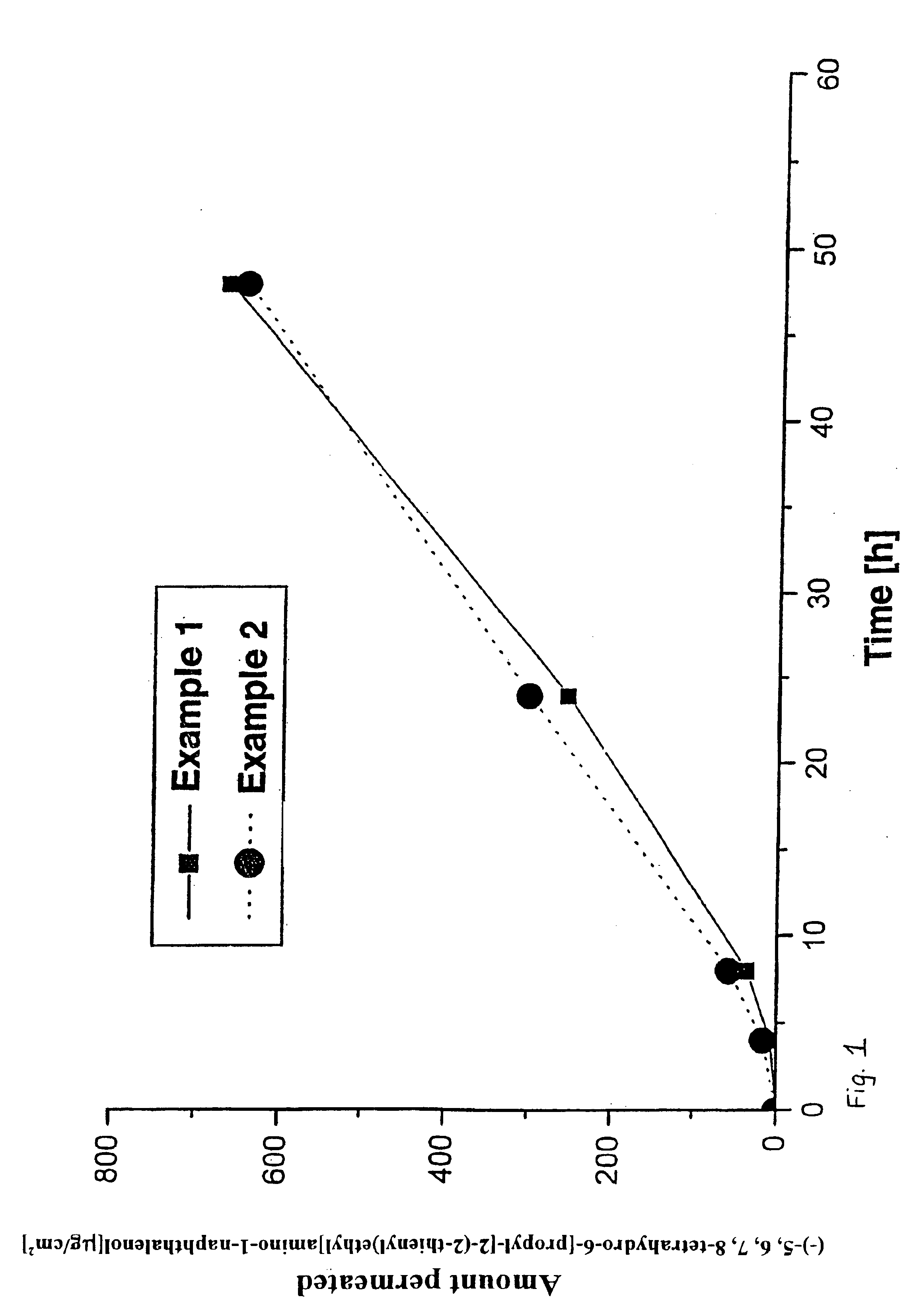Transdermal therapeutic system which contains a d2 agonist and which is provided for treating parkinsonism, and a method for the production thereof
a technology of d2 agonist and transdermal therapy, which is applied in the field of transdermal therapy system for the treatment of parkinson syndrome, can solve the problems of difficult production of transdermal system using this emulsion, difficult to manufacture, and difficult to achieve the effect of reducing the number of patients
- Summary
- Abstract
- Description
- Claims
- Application Information
AI Technical Summary
Problems solved by technology
Method used
Image
Examples
example 1
Polyacrylate System with (−)-5,6,7,8-tetrahydro-6-[propyl-[2-(2-thienyl)ethyl]amino]-1-naphthalenol
[0030]66 g of a 50% solution of Eudragit E100 in ethyl acetate are added to 264 g of a solution of a polyacrylate adhesive having a solids content of 50%; after addition of 36 g oleyl alcohol, the mass is homogenized by stirring.
[0031]Thereafter, 89.65 g (−)-5,6,7,8-tetrahydro-6-[propyl-[2-(2-thienyl)ethyl]amino]-1-naphthalenol are dissolved in 200 ml methylethylketone and added to the above-mentioned mass while stirring. After homogenization of the mass, it is coated onto a siliconized polyester film using a suitable doctor knife. The thickness of the moist film is adjusted such that after removal of the solvent by drying for 30 minutes at 50° C. a coat weight of 60 g / m2 results.
[0032]The dried matrix film is then laminated with a 13 μm-thick polyester film. From the resultant patch laminate, the finished patches are punched out at the desired size, and packed in packaging material ba...
example 2
Silicone System with (−)-5,6,7,8-tetrahydro-6[propyl-[2-(2-thienyl)ethyl]amino]-1-naphthalenol
[0035]18 g (−)-5,6,7,8-tetrahydro-6-[propyl-[2-(2-thienyl)ethyl]amino]-1-naphthalenol dissolved in 40 g ethanol are added to 24 g of a 25% solution of Kollidon 90F and the mass is homogenized. Subsequently, 251 g of a solution of an amineresistant silicone adhesive having a solids content of 70% are added to this mass, and the mass is homogenized by further stirring.
[0036]Subsequently, the mass is coated, using a suitable doctor knife, onto a polyester film (Scotchpak 1022) that has been rendered adhesive, at such a thickness that after removal of the solvents by drying for 30 minutes at 50° C. a coat weight of 50 g / m2 results.
[0037]The dried matrix film is then laminated with a 13-μm-thick polyester film. From the resultant patch laminate the finished patches are then punched out in the desired size, and packed in material bags.
[0038]The concentration of (−)-5,6,7,8-tetrahydro-6-[propyl-[2...
example 3
Polyacrylate System with the Hydrochloride of (−)-5,6,7,8-tetrahydro-6-[propyl-[2-(2-thienyl)ethyl]amino]-1-naphthalenol
[0041]10 g of the hydrochloride are worked into 70 g polyacrylate adhesive (Durotak 387-2287, solids content 50%, National Starch & Chemical), and subsequently 4 g oleic acid are added. The mass is then coated onto a siliconized polyester film at such a thickness that after the removal of the solvents a coat weight of 60 g / m2 results. The solvents are removed by drying for 15-20 minutes at a temperature between 40 and 80° C. Thereafter, the dried matrix layer is laminated with a 12-30 μm thick polyester film, and the patches are punched out.
PUM
| Property | Measurement | Unit |
|---|---|---|
| weight | aaaaa | aaaaa |
| mass | aaaaa | aaaaa |
| temperature | aaaaa | aaaaa |
Abstract
Description
Claims
Application Information
 Login to View More
Login to View More - R&D
- Intellectual Property
- Life Sciences
- Materials
- Tech Scout
- Unparalleled Data Quality
- Higher Quality Content
- 60% Fewer Hallucinations
Browse by: Latest US Patents, China's latest patents, Technical Efficacy Thesaurus, Application Domain, Technology Topic, Popular Technical Reports.
© 2025 PatSnap. All rights reserved.Legal|Privacy policy|Modern Slavery Act Transparency Statement|Sitemap|About US| Contact US: help@patsnap.com



